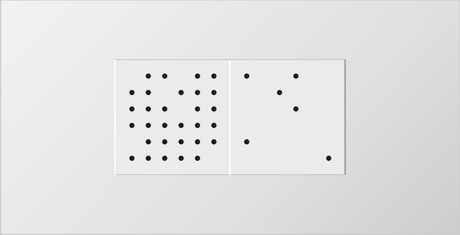Sequences and subsequences in art
Hartmut Böhm
The German artist Hartmut Böhm (*1938) has created a multitude of art work,
in which (mathematical) sequences are included. The representation of the terms
of the sequence must be constricted to a finite choice of sequence terms (normally
the first few).
Böhms work Relief 6 Punkte 1,4,9,16,25,36 from the year 1959 shows the sequence of
natural numbers split into two subsequences:
 Hartmut Böhm:
Hartmut Böhm:Relief 6 Punkte 1, 4, 9, 16, 25, 36 (1959). Wood, Card, Lack. 40 x 80 x 4 cm.
If you lay both squares of the picture on top of one another, then you can recognise that the points of one part fits exactly in the wholes of the other part. If you number the black dots line by line from left to right and top to bottom, then you observe that the dots on the right hand side are always given the value of a square number:
Let (
a
n
)
n
:=
n be the sequence of natural numbers.
Then:
| ( b n ) n | = 1̸ , 2 , 3 , 4̸ , 5 , 6 , 7 , 8 , 9̸ ,... = | ||
| = 2 , 3 , 5 , 6 , 7 , 8 ,...und | |||
| ( c n ) n | = 1 , 2̸ , 3̸ , 4 , 5̸ , 6̸ , 7̸ , 8̸ , 9 ,... | ||
| = 1 , 4 , 9 , 16 ,... |
Suzanne Daetwyler
There are some similar aspects in the work of the Swiss artist Suzanne Daetwyler. Here we also have it that the picture is based on the sequence of natural numbers ( a n ) n , in which a subsequence is highlighted:
 Suzanne Daetwyler:
Suzanne Daetwyler:Primzahlenbild (prime numbers picture) 1-9216 (1996). Acrylic on canvas. 96 x 96 cm.
As the title suggests, here the prime numbers are the determining element of the picture. The fact that the numbers 2 and 3 are the only primes which follow from each other, leads the eye to the centre of the picture: only there do more coloured squares touch one an other without a gap. The squares in the centre of the picture are labelled with the number 1. From there, clockwise and spiralling outwards all squares are numbered consecutively; therefore the sequence of natural numbers is designated. Finally squares with prime numbers are highlighted.
The sequence of prime numbers is therefore a subsequence of the sequence of natural numbers.
